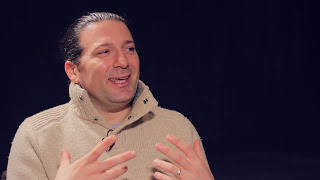Transcript:
Erik Michielsen: How are you improving how you write comedy?
Matt Ruby: I think I’m getting tighter, like in the amount of words that I use, which helps, like the shortest distance between 2 points is a good idea in comedy or in any writing. I think also what do I wanna talk about knowing that. Sort of like knowing what to throw out or what’s just not gonna fit in with the other stuff that I do. You know, just sort of this filter of knowing what’s appropriate or not. I don’t know, when I was starting out, I think a lot of times, like, I would go from A to B with a punch line and I’m getting better at going from A to C, like A to B is just like: oh, yeah, yeah, that’s funny-ish and that’s exactly where people would expect it to go. Whereas A to C is like: oh, I thought it was going in that direction, but I didn’t realize it would go that far, or that twist or that thing. And kind of giving that extra spice or, you know, like a little bit more of like—to me that’s the difference between like a good joke and a great joke is like when it’s like: oh, there’s a little twist that you know you didn’t see coming and it was funny all along the way and then there’s something else on top of that that’s even better, and then that’s I think when you get something delightful.
Erik Michielsen: Could you give me an example of a couple of pieces in a routine that you might use, you know, A to B versus A to C?
Matt: Okay, so I have a joke about how girls will drop the boyfriend bomb on me, and how fast it comes, and so I’ll be like, you know, when I’m talking to a girl, I’ll be like, “Hey, how’re you doing?” And she’ll be like, “My boyfriend says I’m fine.” And that’s A to B, you know. Like that’s fine, it’s funny, it gets a laugh. And then, you know, what I’ve added on to that is like, “Okay, can I get a foot-long chicken teriyaki, please? It’s a really judgmental Quizno’s we got here.” That to me is the C, or the taking it and giving it a twist of like that one extra line that’s, okay, it was a perfectly fine joke, but now to me that’s a more interesting or intriguing, or another layer to it that as opposed to just like a quick in and out sort of like meat and potatoes joke.














